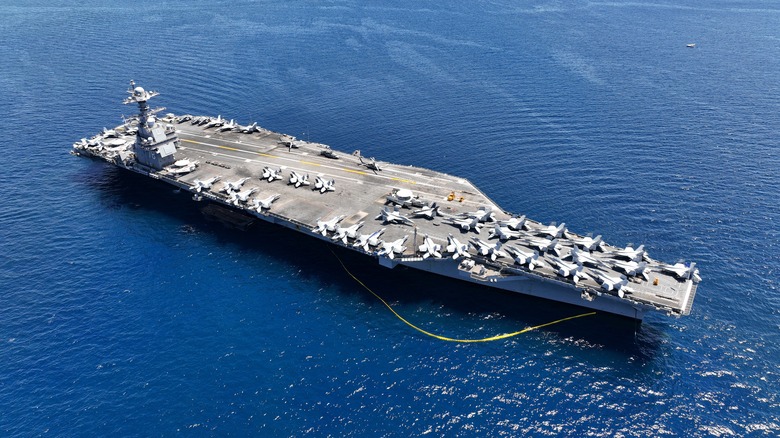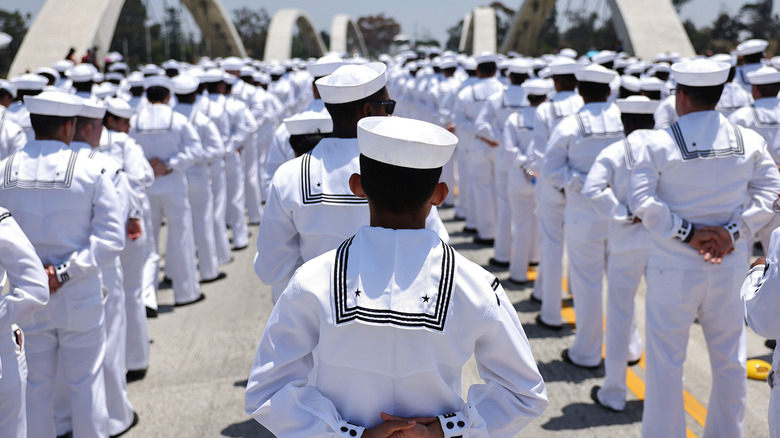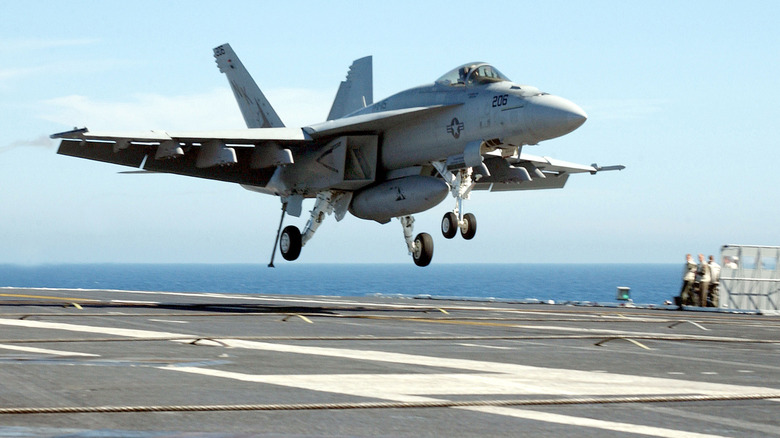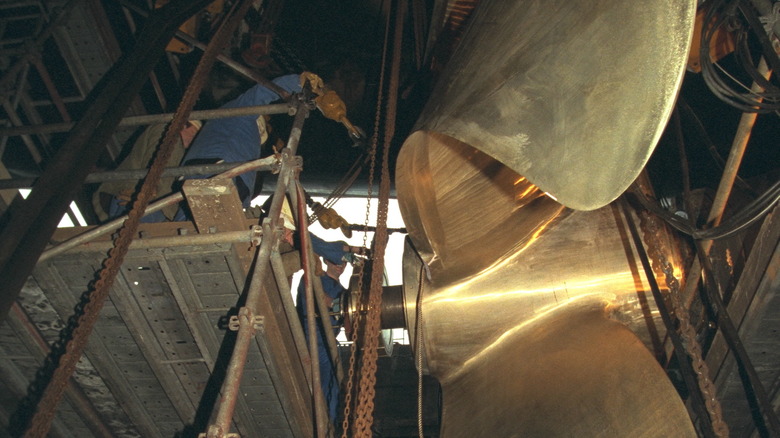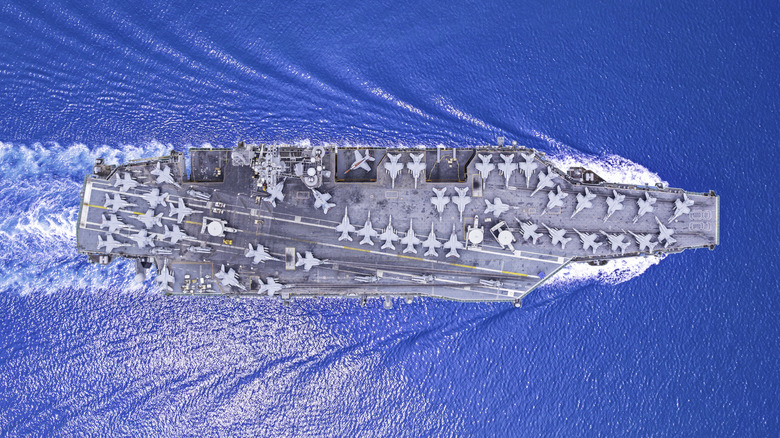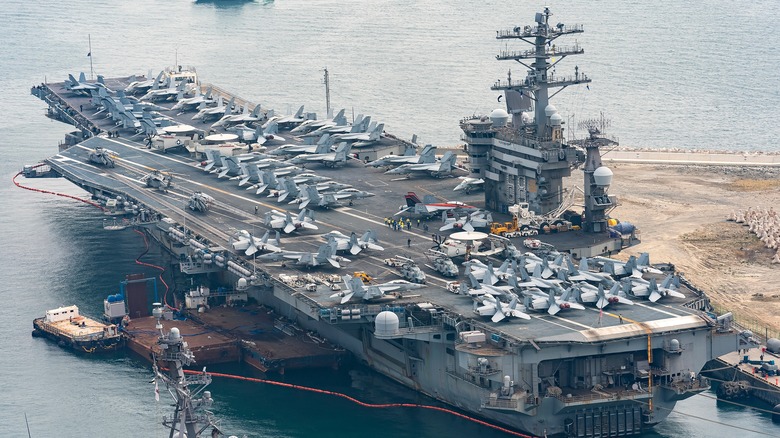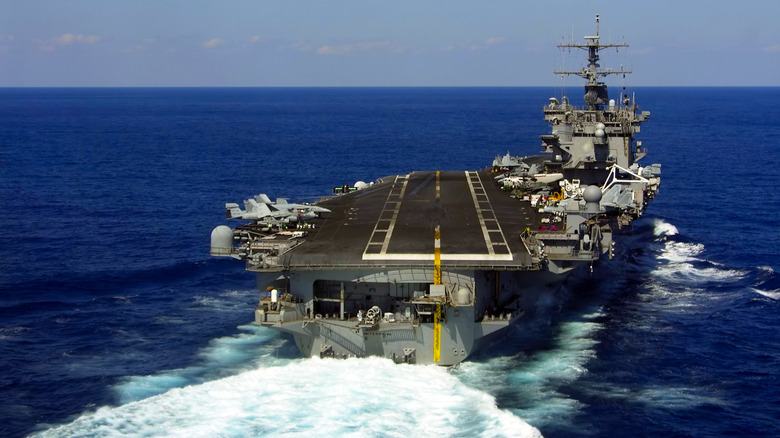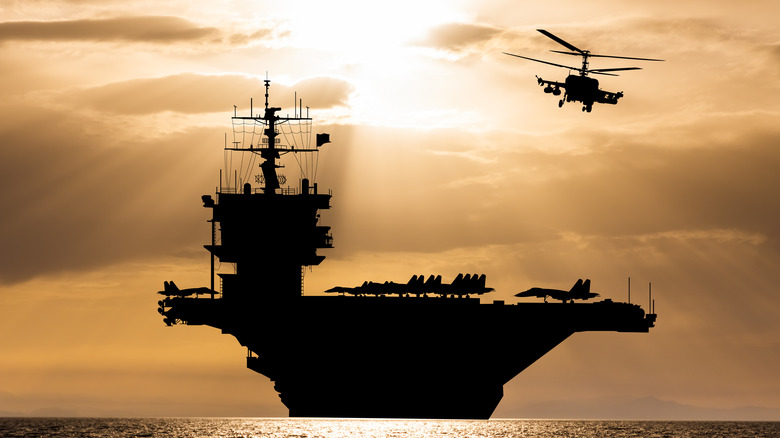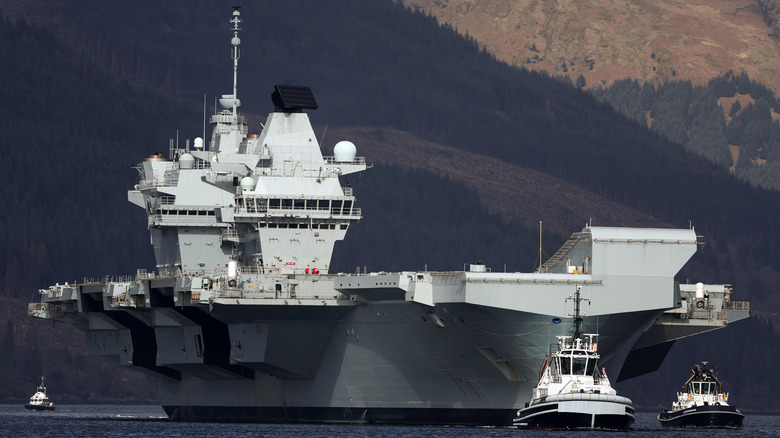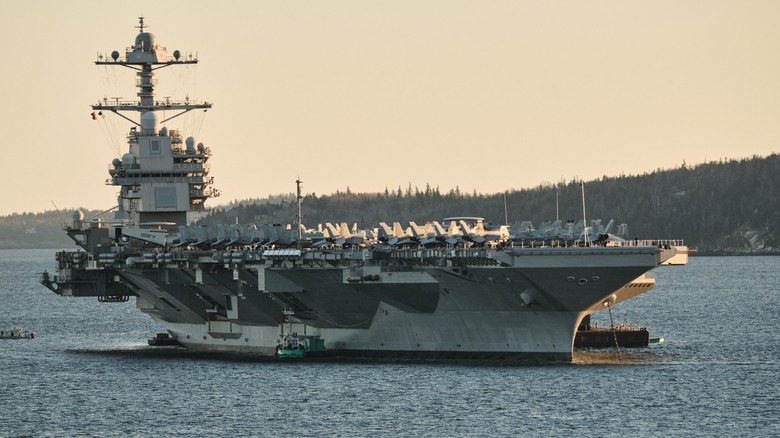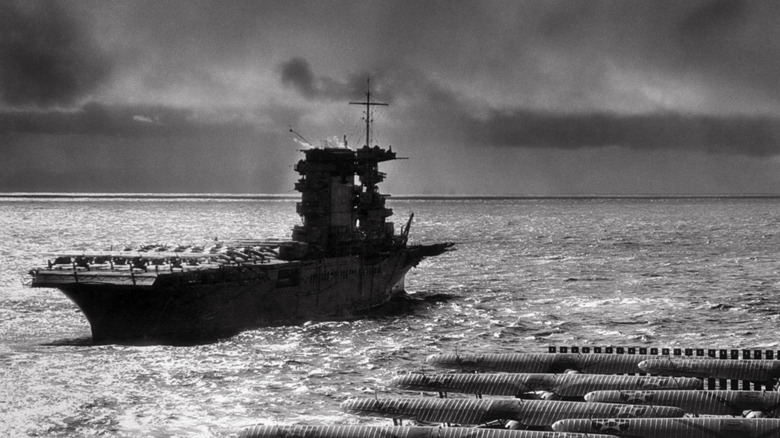10 Interesting Facts You Probably Didn't Know About Aircraft Carriers
Aircraft carriers are the modern marvel of naval forces around the world. They are now a way for countries to demonstrate their power and extend their influence across the globe. Truly massive structures, they are the largest ships in a navy and aircraft carriers have the capacity to house dozens of fighter jets. Acting as mobile air bases, they are more important now than ever before, thanks to the growing use of highly advanced fighter jets.
Understanding the true scale of an aircraft carrier is difficult unless you have seen one in person. They are spectacular vessels that inspire awe and terror in equal measure. Yet, most people only see them as floating runways in movies such as "Top Gun," allowing aircraft to take off and land over water.
The truth is that aircraft carriers are much more interesting and have a more complex role than that. Here are some facts about these behemoths of the sea that you probably had no idea about.
They are home to thousands of crew
If you have ever seen an aircraft carrier up close or know everything the slightest thing about them, then you'll know just how big they are. That massive size, combined with the cramped living quarters that the crew are expected to live, in means that they can be home to a surprising number of people. In fact, they are often known as floating cities due to the sheer size of each ship's complement.
The largest aircraft carriers can carry between 5,000 and 6,000 at their maximum load. The recent Gerald R. Ford class is home to just over 4,000 personnel, while the HMS Queen Elizabeth has a space for 1,600. Around half of those are part of the ship's company, those responsible for maintaining and operating all aspects of the vessel. Another major proportion of the crew is the the air wing, the mechanics who manage the aircraft and the pilots, and any soldiers or marines who may be onboard.
In comparison to other types of ships, the complement of aircraft carriers dwarfs them entirely. Cruisers and Destroyers can each house around 300 crew members, while submarines such as the U.S. Virginia-class vessel can hold a complement of around 130 people. To put that into perspective, the British aircraft carrier HMS Queen Elizabeth can accommodate up to 250 Royal Marines – an elite commando fighting force. That means aircraft carriers can deploy a contingent of fighters that are of equal size to the entire crew of other ship classes.
Landing on an aircraft carrier is particularly difficult
It might sound obvious, but landing on an aircraft carrier is much harder than on a traditional runway. After all, the an aircraft carrier's deck is not only much smaller than a standard runway but also a moving target. Not only are aircraft carriers constantly moving, but they are also buffeted by the open sea as waves and currents affect the vessel. There's also the fact that ocean environments often provide limited visibility and high winds, making landings even trickier. This is true for helicopters and fixed-wing aircraft such as fighter jets. The experience is so challenging that the U.S. Navy is experimenting with ways to automate the process.
One of the ways that engineers have attempted to get around the limitations of aircraft carriers is by introducing catapults and arresting wires. These effectively fire jets off the ship at high speed and help any aircraft slow down suddenly when they land. When landing on an aircraft carrier using this system, pilots have to position their jet so that a tailhook on the aircraft will grab the arresting wires and come to a quick stop. However, even with the help of these systems, landing and taking off is a precise endeavor. Pilots not only have to be highly skilled and hyper-aware of everything they are doing but also rely on guidance from landing signal officers and the Fresnel Lens Optical Landing System.
Aircraft carrier propellers can be over 20 feet long
To get a real understanding of how huge aircraft carriers are, you simply have to look at some of the equipment used on them. Nowhere is that more clear than with the propellers, the metal structures that provide thrust and propel the ship through the water. They obviously need to be fairly large to drive an aircraft carrier, but their dimensions are truly staggering when you put them into context.
The propellers fitted to the HMS Queen Elizabeth and HMS Prince of Wales have a diameter of over 22 feet. To put that into perspective, each of the five shafts is longer than a car. These ships are outfitted with two nickel aluminum bronze propellers, each weighing 33 tons and capable of producing 50,000 horsepower.
The propellers fitted to the supercarriers of the U.S. Navy are even larger. The Nimitz-class aircraft carriers have four 30-ton propellers that are each 25 feet in diameter. They are so big that it takes around 10 minutes for the propellers to warm up and reach their top speed. They are connected to the engines via shafts up to 184 feet long. Amazingly, it can take around 10 months to install and calibrate the propellers on a ship this large.
The ships can be surprisingly fast
You'd probably think that the massive size of aircraft carriers would mean they move at a snail's pace. After all, moving structures that are so large is not an easy task, and the extra weight compared to other ships would suggest that they are slower. Yet, the exact opposite is true. Aircraft carriers are actually among the fastest ships in any navy and are capable of traveling to their destination at a faster pace than any other large ship and outrunning even submarines.
The 35 mph pace of both the Gerald R. Ford and Nimitz classes means that they are well protected from most forms of attack and comfortably faster than any other warship. In fact, the U.S. Navy has never confirmed the top speed of these vessels, only revealing that they can travel in excess of 30 knots. For example, the British HMS Queen Elizabeth was able to reach travel at 32 knots in trials — closer to 37 mph.
While some ships move more quickly, these are typically patrol boats or smaller ships that don't fulfill the same kind of roles as larger ships, such as frigates and destroyers. These are typically limited to speeds of around 25 to 30 knots. Due to their speed, an aircraft carrier is capable of moving to anywhere inside a 6,000 square miles area within just 90 minutes.
A single aircraft carrier can be a massive structure
By their very nature, aircraft carriers have to be big in order to carry out their function. Aircraft of all shapes and sizes land on aircraft carriers, and although they are much smaller than normal runways, still need a sizable flight deck to allow that to happen. Even the smallest major aircraft carriers are still massive by the standards of other naval warships. The FS Charles de Gaulle can displace 42,500 tons when fully loaded and is more than 850 feet long.
Yet, even that figure pales in comparison to the likes of the HMS Queen Elizabeth or the Chinese aircraft carrier Shandong. These two ships displace in excess of 60,000 tons and can carry dozens of aircraft, including fighter jets and helicopters. However, the true kings of the sea when it comes to size are the U.S. supercarriers such as the Nimitz-class and the Gerald R. Ford-class. These displace around 100,000 tons, are over 1,100 feet in length, and have a height of 250 feet. That means they are longer than three football pitches laid end to end and are taller than a 25-floor building.
Various power methods are used in aircraft carriers
Modern American aircraft carriers such as the Nimitz-class and Gerald R. Ford-class vessels utilize nuclear reactors to provide the power needed to move through the water. This gives them a number of advantages over traditional steam power or using other forms of fuel. The ships don't need to be docked as often as there is no need to refuel them as regularly as other aircraft carriers, and as the fuel is contained in the reactor, it doesn't take up valuable space in storage.
But there are relatively few nuclear-powered aircraft carriers in operation today. Outside of the U.S., only France has an aircraft carrier that uses a nuclear reactor in the form of the Charles de Gaulle. Most other vessels make use of more traditional fuel. For example, the HMS Queen Elizabeth has large diesel generators that power the propellers. Others use gas turbines, which are less fuel-efficient than nuclear reactors but are far cheaper to build and maintain.
Russia's Admiral Kuznetsov is a unique aircraft carrier because it uses Mazut for fuel. This tar-like substance was previously widespread in navies around the world but has largely been phased out because it is toxic, liable to cause fires, and leaves a trail of thick black smoke wherever it goes.
Aircraft carriers can stay at sea for a long time
Aircraft carriers are intended to operate as mobile air bases that can travel around the world and remain active for lengthy periods. This allows the fighters and other aircraft onboard to provide air support and carry out strike missions. But just how long can an aircraft carrier stay at sea? Well, the answer depends on the particular ship, but it is larger than you might imagine.
Those that run on nuclear power, such as the Nimitz and Gerald R. Ford classes, are technically able to remain at sea without refueling for an unlimited amount of time. That's because the reactor can run for decades without the need for it to have new fuel. What actually limits the amount of time an aircraft carrier has is its provisions, such as food and water. Special ships can replenish these provisions at sea, as well as provide fuel to ships that don't use nuclear power to get rid of the need to dock at a port.
While that might sound like it would be uncomfortable for the crew on the aircraft carriers that remain at sea for extended lengths of time, that isn't necessarily the case. These types of vessels have a range of facilities, such as gyms, medical centers, and religious chapels. Some even have Starbucks outlets to provide coffee to sailors and barbers to keep hair under control.
Billions of dollars are spent on building aircraft carriers
The biggest aircraft carriers are comparable in size to the largest cruise ships, although they don't exactly stack up when it comes to cost. Whereas the Royal Caribbean cruise ship Icon of the Seas cost the company $2 billion to build, the latest aircraft carrier that went into service in the U.S. Navy — the USS Gerald R. Ford — had a price tag of $13 billion.
That doesn't account for the $5 billion or so in research and development. The entire program for the new aircraft carrier, which will replace the Nimitz-class, is expected to be at least $120 billion — not far away from the entire net worth of Bill Gates. Much of that cost comes from the materials used to build the vessels and the decade-long construction time. According to the Science Channel, it takes more than 60,000 tons of steel and at least 2,500 workers to get an aircraft carrier seaworthy.
Not all aircraft carriers are necessarily as expensive as this. The U.S. ships are the largest in the world and come packed with the most advanced technology available. Other ships from nations such as the United Kingdom are not quite as pricey. The HMS Queen Elizabeth went over budget by £2 billion, taking the overall cost to £6.2 billion ($8 billion). Even that is notably cheaper than what the U.S. government had to pay to get the USS Gerald R. Ford built.
Plumbing costs can be astronomical
Aircraft carriers are not just incredibly expensive to build, but they also cost vast amounts of money to maintain and keep operational. The running cost for the Gerald R. Ford class will run into the billions of dollars over its lifetime, which is still a significant saving compared to the older Nimitz-class aircraft carriers it is set to replace. Estimates suggest the U.S. Navy will save around $5 billion compared to its predecessor.
To put that into context, the running cost of the HMS Queen Elizabeth — a large but significantly smaller aircraft carrier than the Nimitz or Gerald R. Ford class — is around £96 million per year ($124 million). That translates to the Royal Navy spending roughly $340,000 a day or $2.4 million a week on keeping the ship in condition to sail. Estimates suggest that the Nimitz-class ships have operating costs of over $230 million per annum.
What is staggering is how much money is spent on mundane things that most people would not even think about. Bloomberg highlighted a report that suggested the sewage system on the USS George H. W. Bush and USS Gerald R. Ford do not work completely as intended. Frequent clogging means they have to be washed out with a special mixture that contains acid, a procedure that costs $400,000 every time it is carried out.
Aircraft carriers originated during World War I
The aircraft carrier is certainly new in the history of naval warships, with European nations having navies that stretch back hundreds of years. That makes sense, though, as before the invention of powered aircraft, there was absolutely no need for an aircraft carrier. However, the early 1900s saw authorities realize the military potential of even early aircraft, and armed planes were soon developed. By the end of the First World War, planes were increasingly being used in war settings, leading to the need for ships that would allow planes to carry out missions without needing a nearby air base.
The British Royal Navy experimented with an aircraft carrier with a proper flight deck during the First World War, although the HMS Argus was not complete by the time the war ended. Military forces from other countries followed the British example, and by the early 1920s, both the U.S. and Japan had built aircraft carriers that allowed small planes to take off and land.
Aircraft carriers can trace their origins back even further. In the 19th century, the Royal Navy utilized some of its ships to launch kites and balloons, often used to deliver propaganda to enemy territory. Later vessels were able to launch balloons and airships with more offensive capabilities. These incendiary balloons carried a payload that would ignite when the balloon landed on its target.
